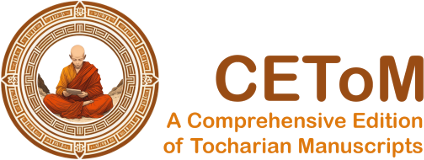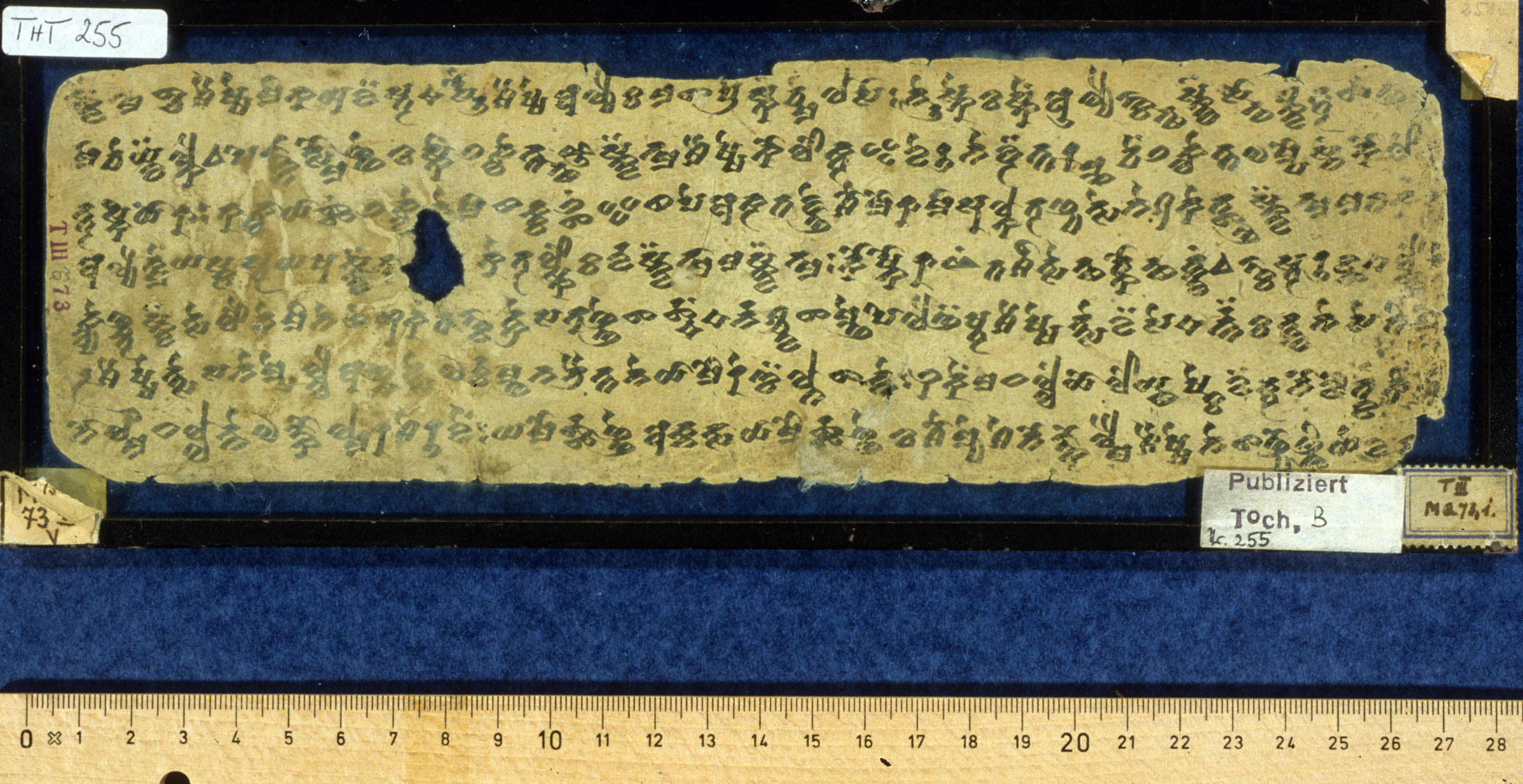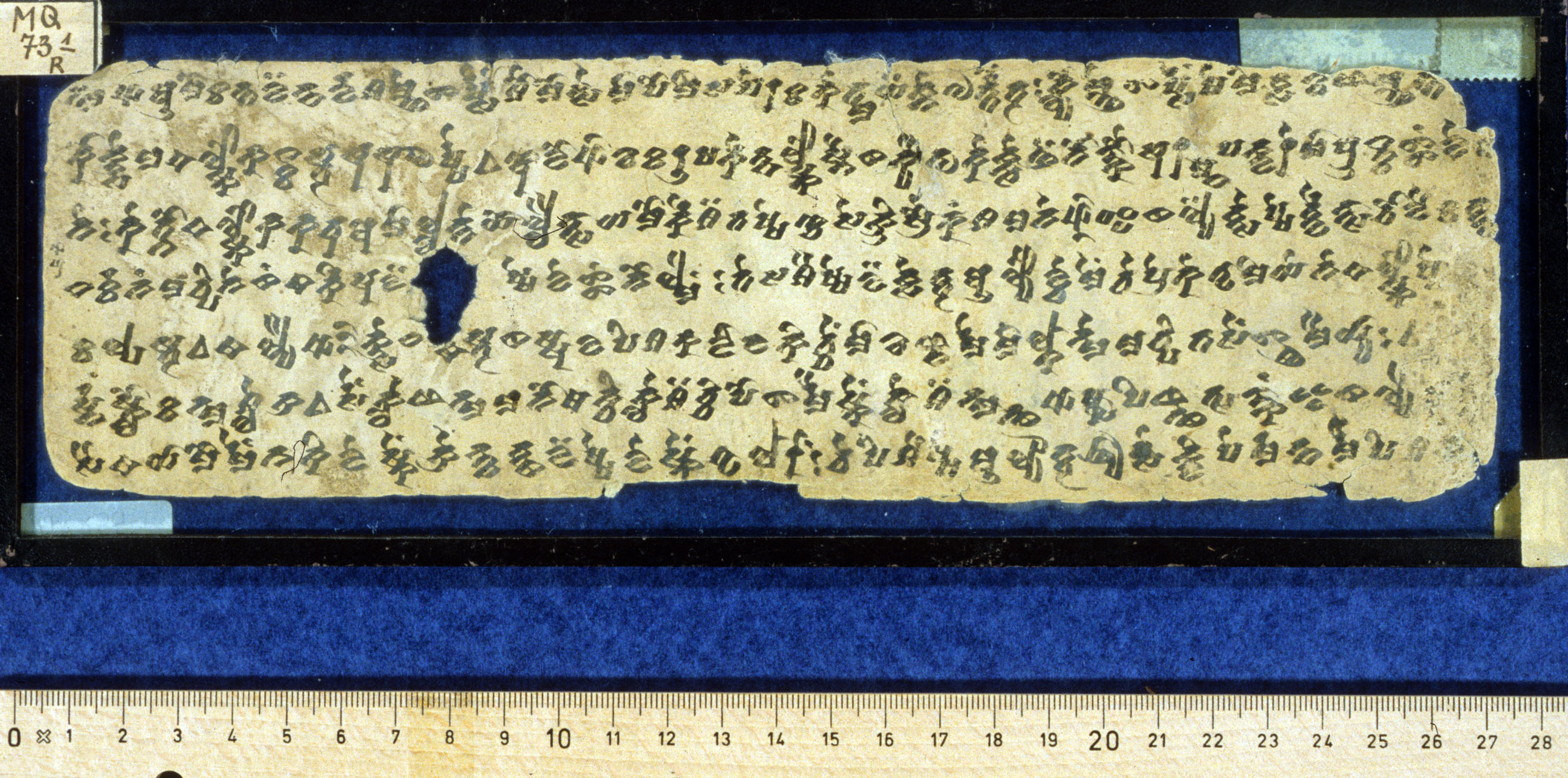THT 255
| Known as: | THT 255; B 255; Bleistiftnummer 251x |
|---|---|
| Cite this page as: | "THT 255". In A Comprehensive Edition of Tocharian Manuscripts (CEToM). Created and maintained by Melanie Malzahn, Martin Braun, Hannes A. Fellner, and Bernhard Koller. https://cetom.univie.ac.at/?m-tht255 (accessed 06 Jul. 2025). |
Provenience | |
| Main find spot: | Kizil Ming-öy |
| Expedition code: | T III MQ 73.1 |
| Collection: | Berlin Turfan Collection |
Language and Script | |
| Language: | TB |
| Linguistic stage: | archaic |
| Script: | archaic |
Text contents | |
| Text genre: | Literary |
| Text subgenre: | Kāvya |
| Verse/Prose: | verse |
| Meter: | 4343 (4x) |
Object | |
| Material: | ink on paper |
| Form: | Poṭhī |
| Number of lines: | 7 |
Images
Images from idp.bl.uk by courtesy of the International Dunhuang Project, the Berlin-Brandenburgische Akademie der Wissenschaften, and the Staatsbibliothek zu Berlin – Orientabteilung.
Transliteration
| a1 | skw[ä] nma s̝ca śai ṣṣe mā ka yu wä stra ma rsau¯ ¯u śai ṣṣe a lye ka ma s̝a pr[ā] skaṃ cme lā sā : ne¯ ¯u ske ai skeṃ ā lye ṅka¯ ¯ts skwä so¯ ¯nt [p]kwä ntra [r]s̝a ñā (–) |
|---|---|
| a2 | mā ce ywä lke e pi ṅkte tsmo ññe ai skeṃ la kle nta¯ ¯ts 6 skwä nma śai ṣṣe ko lo ktra i we ru ne wrä nta ra¯ ¯mt ceṃ la kle nta o mpo staṃ ko lo [ka] |
| a3 | ntra ski y[o] rā : ka klā yā s̝s̝aṃ la kle [n]e mā sa kka ls̝aṃ i sa pe a kṛ ta jñe śau mo rā mā su lkā tra ñya tse ne 7 ke ts̝a¯ ¯ñ skwä nma ma ta kaṃ [sū] |
| a4 | a lye kmeṃ ya ska stra ya ṣu skwä nma ke tra lsko ka rwa skwä nmā ma skwä nma : ko ṣko rā śaṃ ta rśī tse tsa tko tsa t[k]waṃ e ṅka stra ru ks̝a pa ls[k]o (–) |
| a5 | klye ñ[k]tra skwä tse lau te mā ne saṃ 8 k[e] t[e] ṅka tkre sa nu ññe s̝a rs̝paṃ pa rna ścwa s̝a mñe pi le ñä ṣtra śai ṣṣe ntse wä se pa rnnä kä ntwa ne se ti [mi] |
| a6 | ra śai ṣṣe ntse sa ne mpe lle a ñma ntse o rka mña na nrai nta ne yā mo re ñcä lt[ā] s̝a nne : 9 keṃ ma ta llaṃ yo lo y[na] ṣe¯ ¯k wä ntra no w[o] tkaṃ k[r](·)[i] (– –) |
| a7 | no lmi ta llā n[n]e o ṅko lma ra śe ru weṃ : ya mo rs̝s̝a ññe a kna tsā yā mo rs̝s̝a ññe ai śau mye śe no ṅko lmai śai ṣṣe ne s̝a ñyo ññi ye wa (–) |
| lf | 10 8 |
| b1 | nm[a] 10 ā mo ka nta wä nta rwa śa mñe s̝a rpseṃ śau mo tse mā po mī sa pe ra ka ke tm[ā] yä kne o rtt[o] tra : klyo mñe s̝a rpseṃ ṣe mi ksa [ai] śa mñe nta (– –) |
| b2 | ko kuse ma pa lsko ka tka stra su su [o] rṣṣe e ñcu wo 10-1 ai ka ru ṣa ke tpa lsko snai sa kyai tu ke ktse ñä no ṅkau su ra¯ ¯mt pa kwa re mā pru tka s̝s̝aṃ we – |
| b3 | ne : ke tno pa lsko ka ka cu a mā lla tte yo llai ntsā ya mo rke śä ta ṣṣe ñca se krui srau kaṃ śa ma ne 10-2 i sa lyä ntse [ṣ]ṣe rtwe ntsā co wai ka nt[wa] |
| b4 | ta rka naṃ ma cpi ne saṃ [pa] rki su wä ṣṣe we s̝s̝aṃ no lmeṃ : te sa śai ṣṣe wä kse ntra ā lyau wce meṃ ce pre ke [au] mi ye ne pa lsko ṣṣe (–) |
| b5 | ka lpa stra e ma lyai 10 3 kuse ta [n]ma stra sa ssu wa pi śa ka wī [wa] ki cceṃ mā ai śta rme mā lkā nme ma cpi ta seṃ s̝a¯ ¯ñ mai yyā : e – – |
| b6 | rsnaṃ sklo ka nma śle kra e rseṃ kle śa nma ma no ma kci kle śä cci po s̝a rmai skeṃ kle śä nma¯ ¯ts 10 4 pi śa¯ ¯ts tsa ṅkaṃ i sa lye – – |
| b7 | sai ma yā mo rmeṃ na ki we skeṃ kre ntta ntsa wä ṣṣe we skeṃ au lā reṃ : ce pi śai ṣṣe ā lyi ntra ñyā tse kwi pe rma nta rmai pi [ś][a] [n]· – |
Transcription
| lf | 10-8 |
Translation
| a1 | ... the world tends toward pleasures very much. And one who has forgotten the other world does not fear because of rebirths. Oppression they give others, and they expect themselves to be happy. |
|---|---|
| a2 | Not within long, they will pay an interest in sufferings. The world follows plesures like waters during dropsy. |
| a2+ | Sufferings follow after them like a shadow. |
| a3 | Pleasure does not bear (to have) those fallen into suffering close. Like an ungrateful person, it is not seen (when you are) in distress. |
| a3+ | One who doesn't have his own pleasures begs for pleasures as alms from someone else. |
| a4 | To one who has sense, pleasures are reeds, not pleasures. Like a coal pit, the deceptive (pleasure) leads.n2 He concieves of the false falsely. |
| a4+ | The harsh-spirited one always doubts. |
| a5 | There is no opportunity for pleasure (for him). One whose hatred is deep outwardly shows friendship. He seeks for a wound of the world. Poison is outside on his tongue (?). |
| a5+ | This [is] the blindness of the world, a terrible enemy for oneself; |
| a6 | in the dark hells the deed takes hold of oneself. The earth does not support the evil one, but it always covers him if it decides so. |
| a6+ | Good beings carry him like an elephant a hunter. |
| a7 | The fool that is Karma, the wiseman that is Karma, he prods (?) the elephant in the world (?). |
| a7+ | It does not tread (?) its own way. |
| b1 | They point at crafts [and] objects as the humanity of a human, not (just) all meat - the manner of which the faithful one doesn't approve of (?).n3 |
| b1+ | Some point at nobility, others at knowledge. |
| b2 | Whoever does not gladden his mind, he is wooden iron. Whose mind is aikäruṣa, without happiness, he like one who has adorned his body, but is still dressed badly, does not fill his assembly (?). |
| b3 | One whose mind is glad and unoppressed by evil, this one, taking into account the deed, is alive (even) if he dies. |
| b3+ | Through the incitement of discord, one steals the tongue (?). |
| b4 | This is not an advantage for him. He lies to the beings. Because of that, people turn away from eachother this time. |
| b4+ | In the aumiye of the mind, one does not attain heat. |
| b5 | One who begets fifty two excellent sons does not know them if he does not see them. They do not give him their own power. |
| b5+ | Then, he cuts off doubts |
| b6 | and additionally, he causes Kleśas. But the Kleśa-afflicted ones do not give all cause for the Kleśas themselves. |
| b6+ | If from the five discordance arises, having made the lie their refuge they blame the good ones |
| b7 | and tell lies about their companions. Would they ward off this world and will they bow for distress and shame? |
Other
| a1 | Die Bedrückung geben sie anderen [und] vertrauen auf ein glückliches eigenes Selbst. (Schmidt 1974: 174, 317) |
|---|---|
| a1 | (Besitztümern) [und] Glücksgütern wendet sich die Welt sehr zu. (Schmidt 1974: 296) |
| a1 | Sie vertrauen auf ein glückliches eigenes Selbst. (Schmidt 1974: 309, fn. 3) |
| a2+ | Ihr [scil. der Welt] folgen die Leiden nach wie ein Schatten. (Schmidt 1974: 74) |
| a2+ | Den Glücksgütern folgt die Welt, wie das Wasser [Im Toch. Plural] bei Wassersucht [folgt]. Ihr [scil. der Welt] folgen die Leiden nach wie der Schatten. (Schmidt 1974: 290) |
| a3 | Die in Leid Gefallenen erträgt das Glück nicht in [seiner] Nähe. Wie ein undankbarer Mensch lässt es sich in der Not nicht blicken [wtl. wird es nicht gesehen]. (Schmidt 1974: 76, 234-5) |
| a3+ | Wer keine eigenen Glücksgüter hat, der erbittet [sie] von einem anderen [d.h. ist von dem Verlangen danach erfüllt und gibt dem Ausdruck]. (Schmidt 1974: 90, 149) |
| a4 | Wenn eine Hütte die Verkehrtheit eines Betruges(?) bedeckt, [so] wird sie [scil. die Hütte; oder das?] als verkehrt empfunden [wtl. aufgefasst]. (Schmidt 1974: 85, 241) |
| a4+ | Ein rauhes Denken erhebt stets Zweifel, für Glück ist kein Augenblick [da]. (Schmidt 1974: 175) |
| a5+ | This [is] the blindness of the world, a terrible enemy for oneself; in the dark hells the deed takes hold of oneself. (Peyrot 2013b: 432) |
| a6 | The earth does not support the evil one, but it always covers him if it decides [so]. (Peyrot 2013b: 317) |
| a6 | Die Erde erträgt nicht den Bösewicht(?): stets verhüllt sie sich(?), wenn er entscheidet(?). (Schmidt 1974: 42, 300) |
| b1 | Die ganze Person(?) [wtl. das ganze Fleisch] ist nicht vertrauenswürdig, deren Art nicht gelobt wird. (Schmidt 1974: 240) |
| b2 | Wer das Denken nicht erfreut, der ist ein hölzernes Eisen. (Schmidt 1974: 506) |
| b3 | He who is alive takes the deed into account [only] when he dies. (Peyrot 2013b: 326) |
| b4+ | [Selbst] im Fieber des Denkens erlangt er (keine) Hitze. (Schmidt 1974: 195) |
| b5 | He who fathers fifty-two distinguished children does not know them if he does not see them, [and] they do not give him their own power. (Peyrot 2013b: 683) |
| b5 | Wer sich zweiundfünfzig ausgezeichnete Söhne erzeugt, [der] kennt sie nicht, wenn er sie nicht sieht. (Schmidt 1974: 422) |
| b6+ | If from the five discordance arises, having made the lie their refuge they blame the good ones and tell lies about their companions. (Peyrot 2013b: 674) |
| b7 | Would they ward off this world and will they bow for distress and shame? (Peyrot 2013b: 358) |
| b7 | Diese fünf [Mächte] sollen [zwar] die Welt fernhalten, sollen sich aber der Not und Scham beugen. (Schmidt 1974: 304, 501) |
Commentary
Parallel texts
| THT 254 |
Linguistic commentary
| n1 | perakä for perāk. |
|---|
Philological commentary
| n2 | For koṣkoas "coal-pit", see Bernard and Chen 2022, who I also follow in reading rāśäṃas r= āśäṃ. Unlike them, however, I do not correct tarśītseto tarśītsa |
|---|---|
| n3 | The syntax and meaning of this sentence is far from clear. In particular, po mīsais enigmatic. I interpret the relative clause as non-restrictive. |
Alternative linguistic/paleographic classifications
| Peyrot 2008 | A1 |
| Malzahn 2007a | A5 |
| Tamai 2011 | C1 |
| Tamai 2011 | C14 |
References
Online access
Edition
Sieg and Siegling 1953: 155-156
Translations
Hackstein 1995: a1 (192), a3 a4 (184), a4 (118ff, 140, 224), b2 (264), b3 (316), b7 (214); Krause 1952: a6 (65), b7 (122); Peyrot 2013b: a5 a6 (432), a6 (317), b3 (326), b5 (683), b6 b7 (674), b7 (358); Schmidt 1974: a1 (174, 296, 309 n.3), a1 (174, 317), a1 (296), a1 (309, fn. 3), a2 (74), a2 a3 (74), a2 a3 (290), a3 (76, 234f), a3 (76, 234-5), a3 a4 (90, 149), a4 (85, 241), a4 a5 (175), a5 a6 (175), a6 (41 n.2), a6 (42, 300), b1 (240), b2 (506), b4 b5 (195), b5 (59 n.3), b5 (422), b7 (304, 501); Thomas 1957: b3 (268); Thomas 1968: a2 (209), a2 a3 (202), a3 (205), a6 a7 (213); Thomas 1969: a6 (254); Thomas 1979a: a3 a4 (258); Thomas 1979d: b6 (166); Thomas 1985: a2 (92); Thomas 1995: a1 (60)
Bibliography
Bernard, Chams Benoît, and Ruixuan Chen. 2022. “A Fall into the Pit: Tocharian B koṣko, koṣkīye.” Indo-Iranian Journal 65 (1): 1–31. https://doi.org/10.1163/15728536-06501001.
Hackstein, Olav. 1995. Untersuchungen zu den sigmatischen Präsensstammbildungen des Tocharischen. HS Erg.-Heft 38. Göttingen: Vandenhoeck & Ruprecht.
“The International Dunhuang Project: The Silk Road Online.” n.d. http://idp.bl.uk.
Krause, Wolfgang. 1952. Westtocharische Grammatik, Band I. Das Verbum. Heidelberg: Winter.
Malzahn, Melanie. 2007a. “The most archaic manuscripts of Tocharian B and the varieties of the Tocharian B language.” In Instrumenta Tocharica, edited by Melanie Malzahn, 255–97. Heidelberg: Winter.
Peyrot, Michaël. 2008. Variation and change in Tocharian B. Vol. 15. Leiden Studies in Indo-European. Amsterdam/New York: Rodopi.
Peyrot, Michaël. 2013b. The Tocharian subjunctive. A study in syntax and verbal stem formation. Vol. 8. Brill’s Studies in Indo-European Languages & Linguistics. Leiden/Boston: Brill.
Schmidt, Klaus T. 1974. “Die Gebrauchsweisen des Mediums im Tocharischen.” PhD, Universität Göttingen.
Sieg, Emil, and Wilhelm Siegling. 1953. Tocharische Sprachreste. Sprache B, Heft 2. Fragmente Nr. 71-633. Edited by Werner Thomas. Göttingen: Vandenhoeck & Ruprecht.
Tamai, Tatsushi. 2011. Paläographische Untersuchungen zum B-Tocharischen. Innsbrucker Beiträge zur Sprachwissenschaft 138. Innsbruck: Institut für Sprachen und Literaturen.
Thomas, Werner. 1957. Der Gebrauch der Vergangenheitstempora im Tocharischen. Wiesbaden: Harrassowitz.
Thomas, Werner. 1968. “Zur Verwendung von toch. A oki/B ramt und A mäṃtne/B mäkte in Vergleichen.” Orbis 17: 198–231.
Thomas, Werner. 1969. “Bemerkungen zum Gebrauch von toch. A ptāñkät [B pañäkte, pudñäkte], A koṃ [B kauṃ]: A koṃñkät [B kauṃñäkte] usw.” Orbis 18: 235–68.
Thomas, Werner. 1979a. “Ein neues tocharisches Prātimokṣa-Fragment der Bibliothèque Nationale.” Zeitschrift für Vergleichende Sprachforschung 92: 235–68.
Thomas, Werner. 1979d. “Zur Verwendung von A śla, B śale, śle im Tocharischen.” Zeitschrift für Vergleichende Sprachforschung 93: 150–73.
Thomas, Werner. 1985. “Toch. B tsamo < *tsämä́mo?” Indogermanische Forschungen 90: 88–93.
Thomas, Werner. 1995. Zur tocharischen Syntax. Adverbiales A māk, B māka “viel”. Vol. 2. SbWGF, XXXIII. Stuttgart: Steiner.
Gippert, Jost, Katharina Kupfer, Christiane Schaefer, and Tatsushi Tamai. n.d. “Thesaurus Indogermanischer Text- und Sprachmaterialien (TITUS): Tocharian Manuscripts from the Berlin Turfan Collection.” http://titus.fkidg1.uni-frankfurt.de/texte/tocharic/thtframe.htm.




